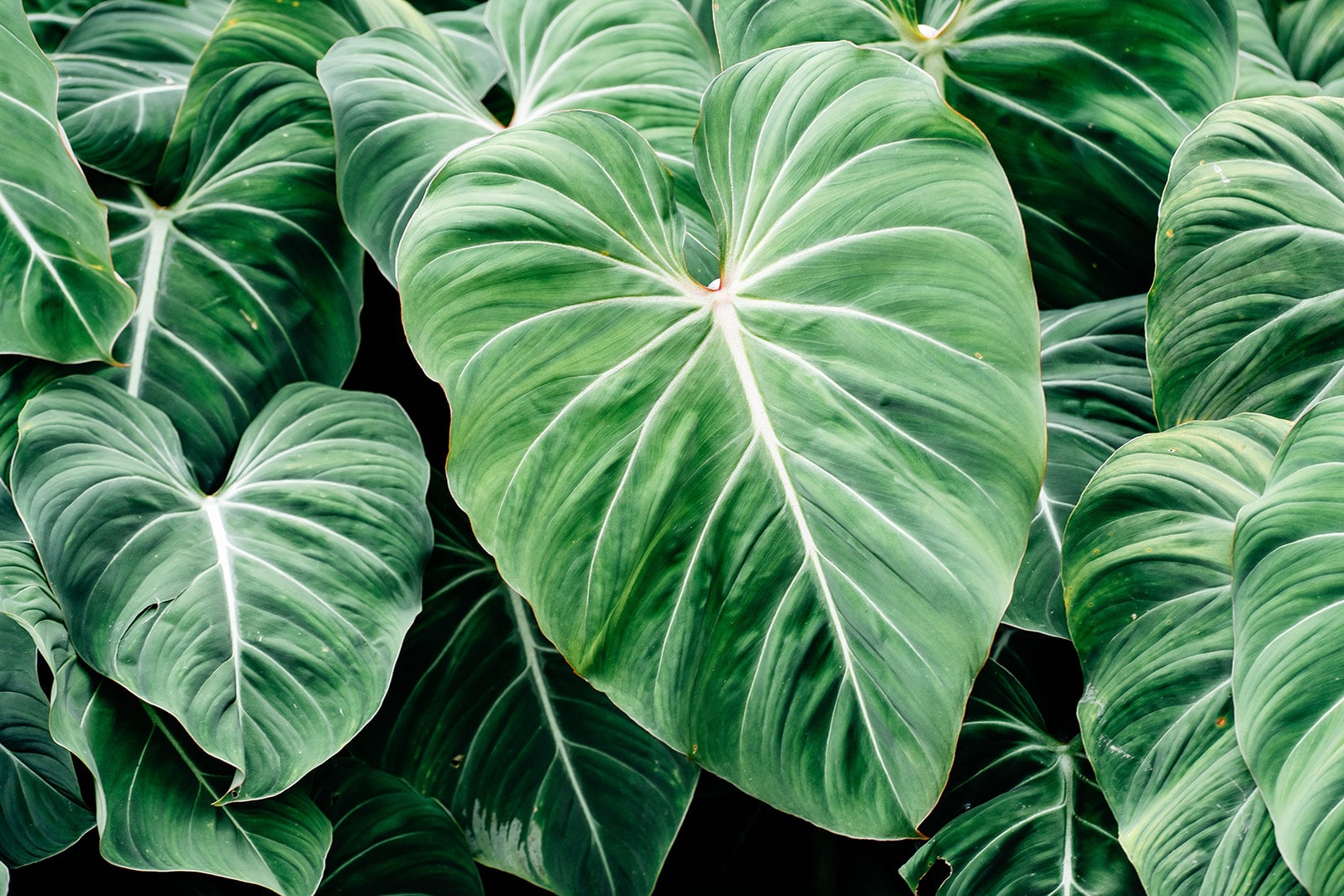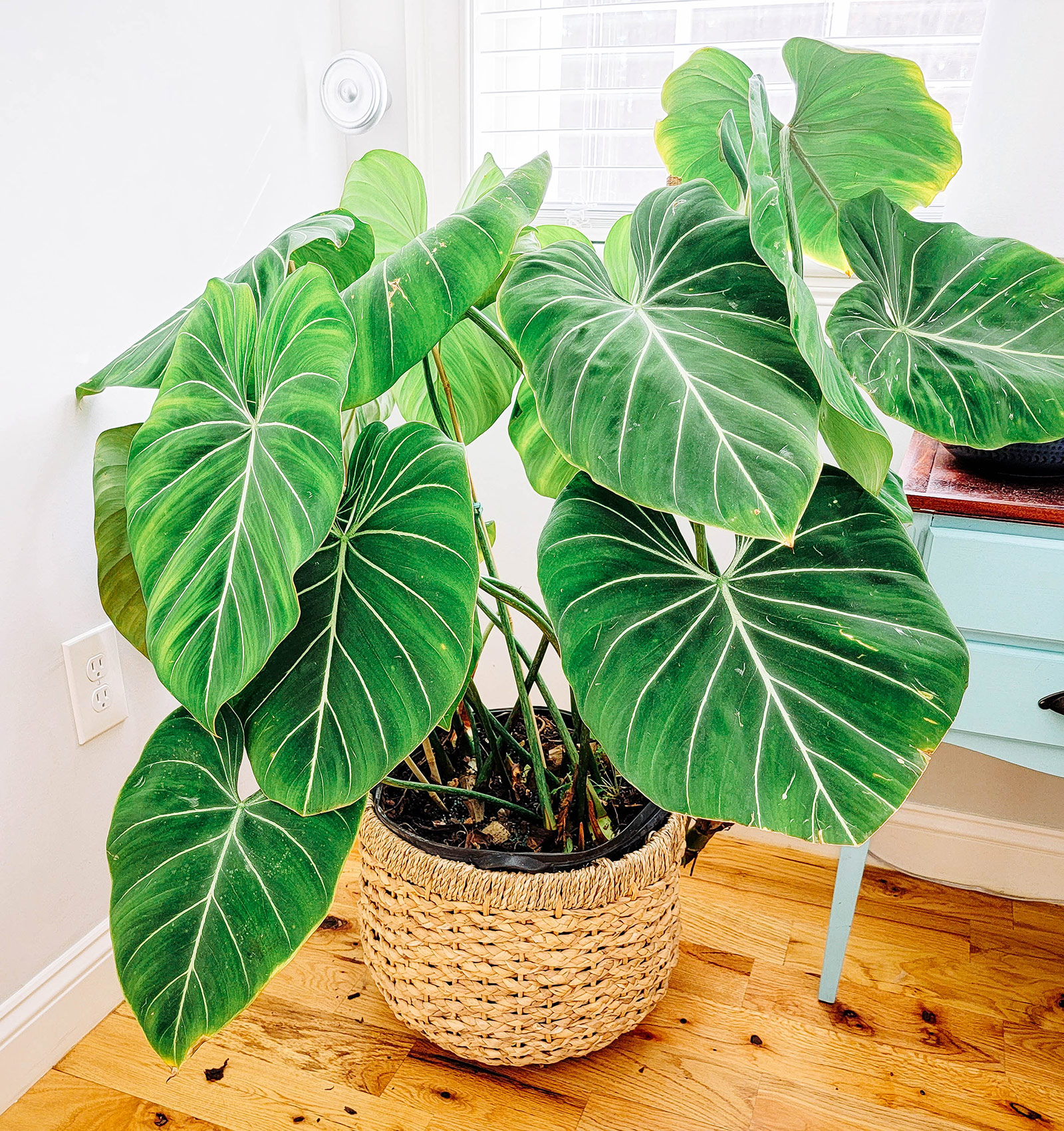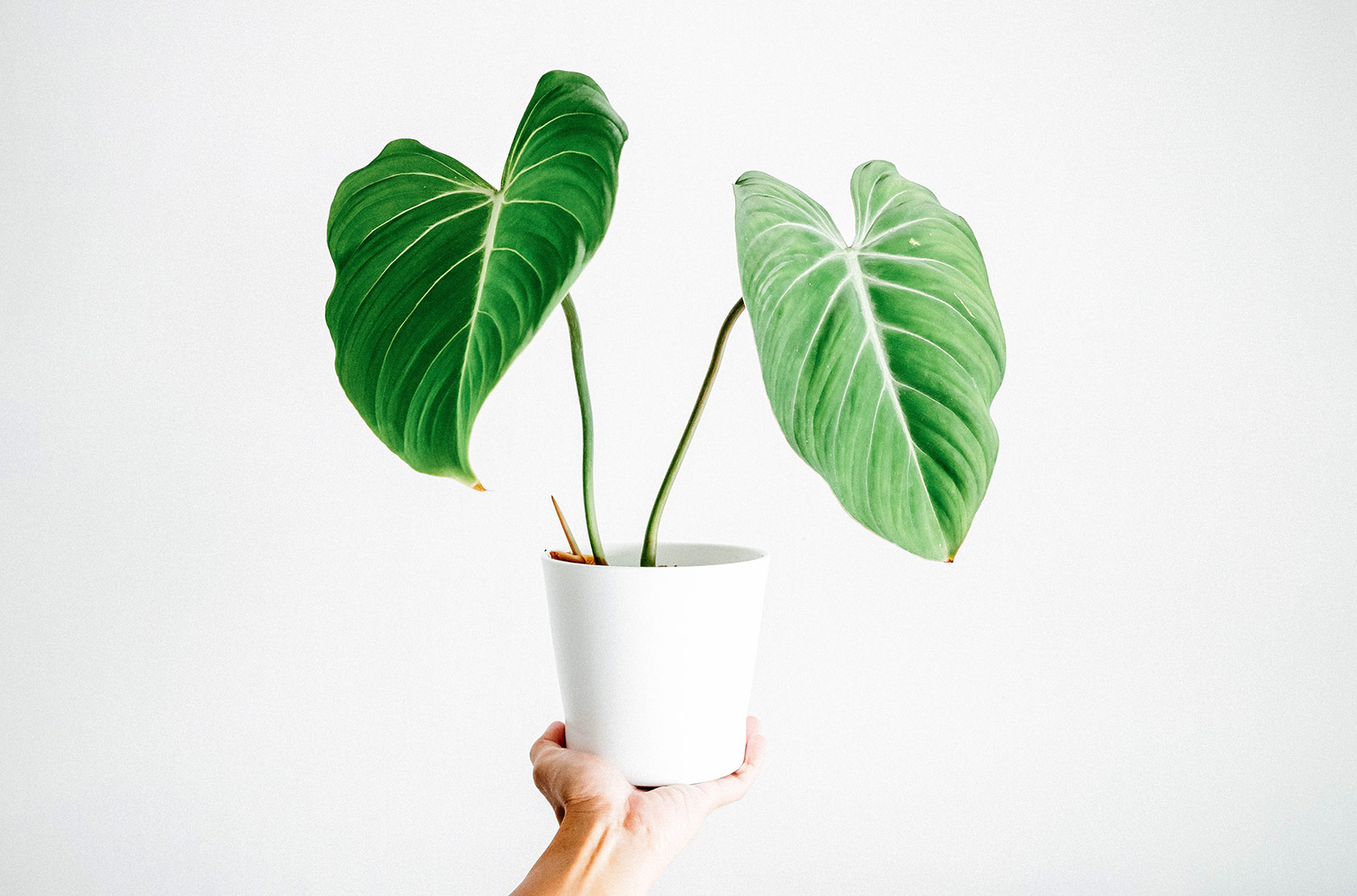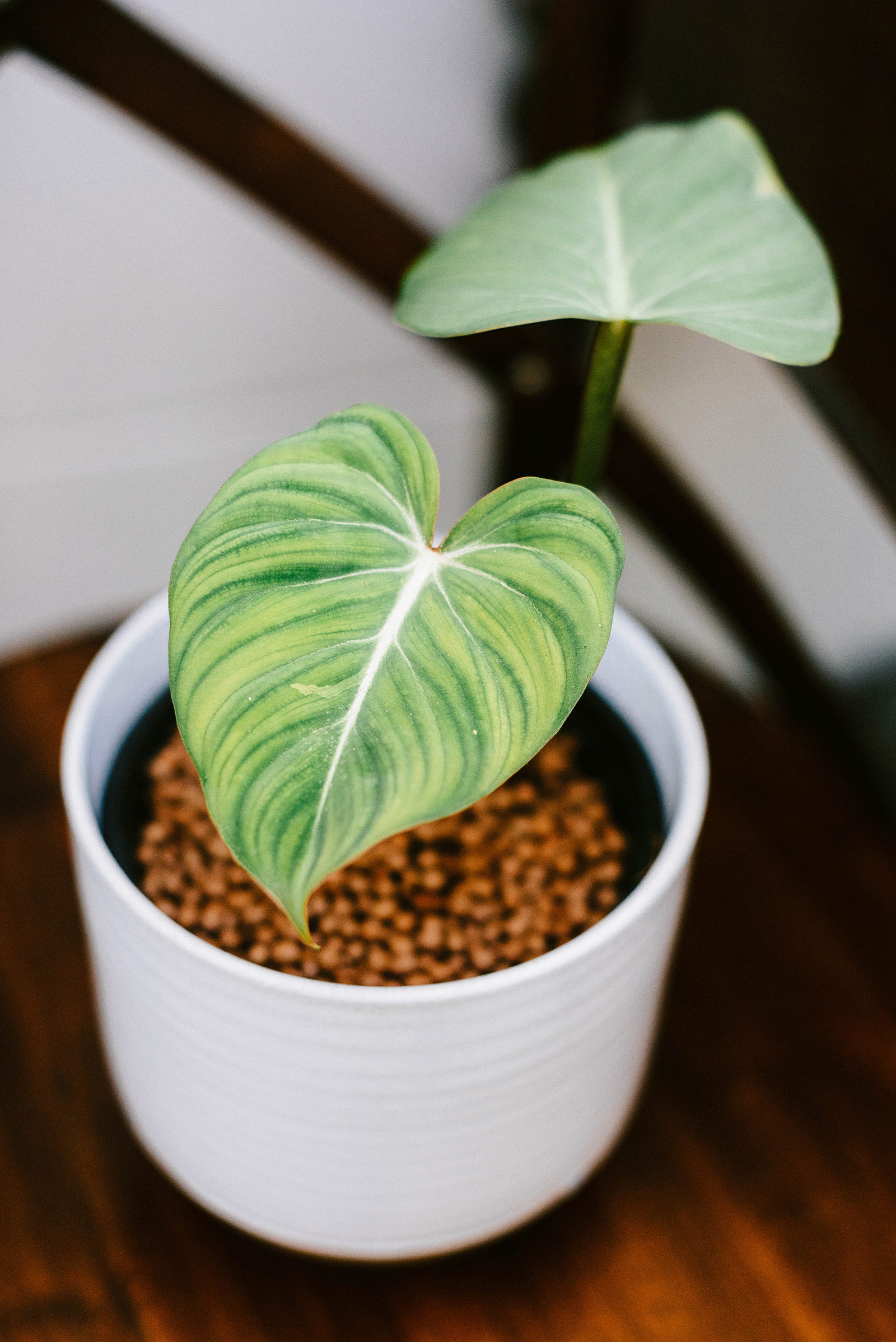Looking for a striking addition to your houseplant collection? There’s a reason Philodendron gloriosum is one of the more popular and coveted aroids out there right now: Its huge, velvety leaves with silvery veins make this one a true eye-catcher.
Let’s go into Philodendron gloriosum care and what you need to know to successfully grow one indoors!
| Common name(s) | N/A |
| Scientific name | Philodendron gloriosum |
| Family | Araceae |
| Height and spread | Up to 3 feet high and 6 feet wide |
| Light | Bright indirect |
| Soil type | Aroid soil |
| Water | Keep lightly moist |
Disclosure: If you shop from my article or make a purchase through one of my links, I may receive commissions on some of the products I recommend.

About Philodendron gloriosum
Natural habitat
This Philodendron species, like many of our other tropical houseplant favorites (Anthurium andraeanum and Tradescantia zebrina come to mind), is naturally found in Colombia. It grows in the Orinoquía region and the lower Andes, at elevations between 300 and 950 meters.
It differs from many of the Philodendron varieties we grow in our homes (such as Philodendron Birkin, Pink Princess, and Brandi) in its growth pattern: rather than being a vining climber, this one prefers creeping across forest floors.
Unfortunately, the species isn’t doing too well in its natural range, with the IUCN listing it as “Vulnerable” with populations decreasing. Its preferred dry forest habitat is under threat due to being cleared for farming, and poaching for the plant trade hasn’t helped the situation either.
Description
Philodendron gloriosum has taken the houseplant world by storm in the past few years, and it’s not difficult to see why. It’s highly desirable for its large, heart-shaped dark green leaves, which are velvety to the touch. (If you feel like you’ve seen this before, it’s pretty similar to Anthurium clarinervium, another tropical aroid.) The leaf veins are a striking, much lighter silvery-green color and can have a pinkish tinge in newer foliage.
A single leaf can grow extremely large in the plant’s natural habitat, and even in cultivation, it’s not uncommon to see leaves that are 26 inches or more across. It’s definitely a head-turner!
Like other aroids (Alocasias, Monsteras, Aglaonemas, and Pothos, for example), gloriosum is grown for its foliage rather than its flowers. It has an unassuming white bloom (known as an inflorescence) consisting of a spathe and a spadix that make up the flower.

Philodendron gloriosum varieties
Even the “basic” version of this aroid isn’t always easy to find, nor does it tend to be reasonably priced. (Why is Philodendron gloriosum so darn expensive anyway?! Find out in my commonly asked questions below.)
To make things even more challenging (and enticing!), there are a few different varieties out there for the dedicated houseplant hobbyist to hunt down.
- Philodendron gloriosum ‘Dark Form’: Darker, rounder leaves with fine veining and a reddish outline on its leaf edges.
- Philodendron gloriosum ‘Zebra’: Bright white, more pronounced veins.
- Philodendron gloriosum ‘Pink Back’: Back of the leaves and veins are pale pink in color.
- Philodendron gloriosum ‘Round Form’: Rounder foliage without a point at the bottom.
- Variegated Philodendron gloriosum: Yep, it’s a thing! Normal foliage interspersed with yellow or cream variegation.
As per usual with Philodendrons and other aroids, hobbyists are also hybridizing their hearts out with Philodendron gloriosum. It can be crossed with various closely related species, so you may stumble upon hybrids like Philodendron gloriosum x melanochrysum or gloriosum x maximum. Some are very nice to look at!
Where to buy Philodendron gloriosum plants:

Caring for Philodendron gloriosum
Light and temperature
Like other plants that naturally form part of the forest understory, Philodendron gloriosum likes bright indirect light. Too much direct sun will burn its leaves, especially without proper acclimation, while keeping it in a spot that’s too dark will result in a sad and spindly-looking plant.
A little morning or evening sun is fine, just don’t overdo it. Place your plant on or near a windowsill, or opt for artificial lighting if your space lacks natural light.
Temperature-wise, it’s important to remember that this species’ natural habitat is in the tropics. It doesn’t like the cold, so try not to let temperatures drop below 59°F.
Room temp is perfect, meaning that if you’re feeling comfy in your home, then the same goes for your Philodendron gloriosum. Higher temperatures aren’t a problem either, as long as the plant isn’t being scorched by the sun.
Water and humidity
Much of the best watering habits for aroids like this one are determined by the potting mixture you use. They’re sensitive to rot from overwatering, especially species like Philodendron gloriosum that form a rhizome. This means it’s a good idea to use a chunky and airy soil mixture that allows excess water to easily flow out of the planter.
As long as the soil is in order, it’s almost impossible to water too much, so be sure to have a look at the next section below for more information about the ideal potting soil composition.
In any case, your Philodendron gloriosum will appreciate being kept lightly moist. You can let the first 1 to 2 inches of soil dry out before watering again during the active summer growing months. During winter, when houseplants aren’t as active and therefore need less water, you can let the soil go about halfway dry.
When it comes to humidity, this definitely isn’t the fussiest member of the aroid family. Still, it doesn’t like things overly dry.
If humidity levels regularly fall below 40 percent (you can track this using an inexpensive humidity meter), this Philodendron, as well as your other houseplants, may appreciate a humidifier. Our homes can be dry during winter especially, which can lead to crispy leaf tips and spider mite infestations. Getting the humidity up to 50 or 60 percent at least is what I suggest for keeping your plant happy.
Soil and planting
The right soil mixture is the key to success with most Philodendrons. They don’t really like being grown in regular potting soil, instead preferring a grittier mixture that offers excellent drainage.
It isn’t hard to mix your own perfect aroid soil, which will help your gloriosum as well as many other popular houseplants thrive. The classic mixture contains equal parts houseplant potting soil, perlite, and orchid bark, although you can experiment a little.
If you find your soil mixture dries out too quickly, you can add some sphagnum moss to retain water better.
Some indoor gardeners also like to use horticultural charcoal (a form of activated charcoal without additives) to help boost plant growth and support overall health. This soil supplement is said to “sweeten” the soil (that is, keep the soil pH over 7.0), rid the soil of impurities like bacteria and fungi, absorb excess moisture to reduce the chances of rot, and repel pests.
As for the best type of planter for a Philodendron gloriosum, it really doesn’t matter too much. The most important thing is that the planter should always have a drainage hole. Given the species’ creeping (rather than climbing) growth habit, can also be handy to go for an extra-wide planter to ensure it has plenty of space to do its thing.
Be sure not to bury the rhizome (the part of the stem where the leaves emerge). Only the roots should be fully covered while the upper half of the rhizome remains exposed.
Recommended products for Philodendron gloriosum plant care:
- Good Earth Organics Premium Potting Soil
- FoxFarm Ocean Forest Potting Soil
- Perfect Plants Organic Perlite
- Better-Gro Orchid Bark
- Better-Gro Orchid Moss
- Espoma Organic Horticultural Charcoal
Fertilizing
Philodendron gloriosum isn’t the quickest grower, but it’ll still appreciate some extra nutrients during the growing season, which runs from spring to around mid-fall depending on where you’re located. This is when houseplants are actively putting out new leaves, as opposed to the sort of “hibernation period” they enter during winter.
You can water with some diluted liquid houseplant fertilizer every other week or so when your Philodendron is actively growing. Don’t fertilize if it’s not showing signs of growth or if it isn’t doing well, or you’ll risk damaging the roots.
Recommended fertilizers for Philodendron gloriosum:
- Maxsea All-Purpose Seaweed Plant Food
- Houseplant Resource Center Liquid Fertilizer for Houseplants
- Instant Biologics Instant Plant Food (Fizzing Nutrient Tablets)
Pruning
Your Philodendron gloriosum won’t need much work in terms of pruning, aside from the occasional removal of dead leaves. It’s normal for plants to drop their older foliage once they feel they don’t need it anymore.
If your plant has grown a little out of control and you’ve decided it needs some taming, have a look at the section on propagation below.
Dividing or repotting
It’s not impossible for your Philodendron gloriosum to produce offshoots at the soil level, which you can remove to easily create a whole new plant. With the prices that this species still fetches, that could be a good way to expand your collection, make gifts for friends, or earn a little extra money on the side!
Just take your Philodendron out of its planter, separate the offset(s) with some clean pruning shears and pot both plants up separately using fresh soil. This way you won’t need to move the mother plant to a larger pot, and you’ve now got an extra specimen to enjoy or sell.
On the other hand, leaving offshoots in the same container as the mother plant makes for a fuller and more impressive display. If you’d like to do this, you can repot during springtime once every year or so, or whenever your Philodendron outgrows its current planter.

Propagating Philodendron gloriosum
Propagating Philodendron gloriosum isn’t too much of a challenge, but it can be a little different than what you’re used to from other plants. They can easily be multiplied by way of division if there are any offshoots (as described in the section above). If that’s not the case, you can opt for rhizome cuttings.
Taking a rhizome cutting from a creeping Philodendron is not too different from taking a stem cutting from a “normal” climbing one. The only real difference is that you don’t make a horizontal cut (removing part of the plant from the top), but rather a vertical one (removing part of the plant from the side). You’ll be cutting between the leaves.
Just locate a part of the rhizome that allows you to make an easy cut and get a part of the plant that has a node (growth point) or two. Including a few leaves is a good idea as well, as a rhizome-only cutting will take much longer to sprout. It can be helpful to take the plant out of its pot to find a good point on the rhizome and make a clean cut.
You can root your gloriosum cutting in water, potting soil, or damp sphagnum moss. To increase humidity levels, consider placing the whole thing in a clear plastic bag while you wait for the rhizome to grow. This creates a sort of mini greenhouse environment and stimulates growth much faster.

Common questions about Philodendron gloriosum care
Why is my Philodendron gloriosum turning yellow?
Yellow leaves on a Philodendron gloriosum can be caused by a number of reasons, the most common being potting soil that’s completely dried out, or potting soil that’s waterlogged. The plant isn’t too picky about watering as long as the first 2 inches of soil stays consistently and lightly moist.
Why is the Philodendron gloriosum so expensive?
Philodendron gloriosum plants are expensive because they’re rare and in high demand. They also grow slowly, limiting the supply, so breeders can charge a premium for these desirable houseplants.
How fast does Philodendron gloriosum grow?
Philodendron gloriosum plants are slow growers. It can take one to two months for a new leaf to unfurl completely.
Is Philodendron gloriosum toxic to cats and dogs?
Although it would be very unlikely for a plant like Philodendron gloriosum to cause serious issues in your furry friends, all aroids produce calcium oxalate crystals. These cause a burning sensation in the mouth and throat when chewed, which can be unpleasant.
If you think your pet has gotten into your Philodendron, offer plenty of water and keep an eye out for swelling.
Sources:
https://powo.science.kew.org/taxon/urn:lsid:ipni.org:names:87777-1
https://www.iucnredlist.org/species/129739546/129739550















